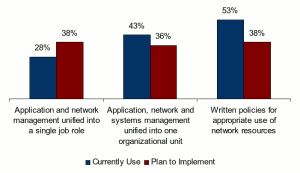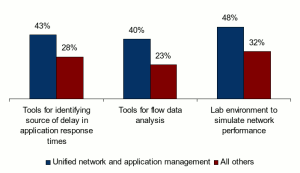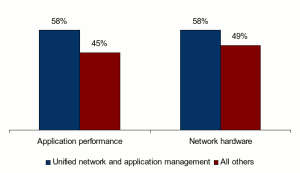
End-user organizations are looking to leverage enterprise applications to achieve competitive advantages and operational efficiencies, and to improve information flow in their value chains. In order to maximize the return on investment from these deployments, organizations are optimizing their networks and ensuring a high level of performance.
Aberdeen’s recent benchmark reports, “Optimizing WAN for Application Acceleration” and “The Real Value of Network Visibility”, show that organizations are deploying various tools for prioritization of network traffic and traffic compression. Also, tools for network monitoring, analytics and simulation are increasingly utilized to streamline business processes through an effective deployment of business-critical applications.
Additionally, organizations are changing the internal structure of their IT departments to achieve optimal performance of applications, enterprise networks, and overall enterprise infrastructure.
One Size Doesn’t Fit All
Aberdeen’s benchmark report, Optimizing WAN for Application Acceleration,” shows that over the last two years, 93 percent of organizations increased their bandwidth capacity by an average of 138 percent. As organizations are paying more for bandwidth services and investing a substantial amount of resources in rolling out new applications, they should keep in mind that these projects could become even more costly if they do not gain visibility into their network performance and the interdependencies between applications, systems and the network. Aberdeen’s research shows that 48 percent of all organizations that increased their bandwidth capacity did not experience any improvement in application performance.
Organizations are beginning to realize that taking an ad-hoc approach to managing application rollouts and network performance is costly. Thirty-eight percent of organizations in Aberdeen’s benchmark report, “The Real Value of Network Visibility,” indicated that unifying operational and strategic goals is the top strategic action they are taking to improve network management. In order to achieve that, these organizations are changing the internal structure of their IT departments and consolidating management of application and network performance into a single job role (Figure 1).
Figure 1 shows that 56 percent of organizations have either created, or are planning to create, a job role that unifies network and application performance management. Additionally, the majority of surveyed organizations have written policies in place for appropriate use of network resources.
To better understand the impact on the adoption rates for different technologies, as well as the impact on overall network and application performance, Aberdeen compared organizations that adopted more of a generalist role for managing both application and network performance to organizations that do not have this capability.
Figure 2 shows that organizations that have IT staff in charge of both applications and network management are more likely to deploy technology solutions for both troubleshooting application response times and analyzing network flow data. These organizations are also more likely to develop tools for simulating network performance in the application pre-deployment stage.
Holistic Synergy
Organizations that have a single employee in charge of network and application performance are more likely to have a more holistic view into interdependencies — both the interdependencies between different applications running on the network, and those between applications and the network itself. More importantly, having this organizational capability gives the IT department a better understanding of the technology solutions required for effective enterprise performance management.
Figure 3 highlights how organizations that have merged network and application management into a single job role experience greater success in resolving issues with application performance and network hardware before end-users get impacted.
However, Aberdeen’s research shows that having this capability in place does not provide operational efficiencies for end-user organizations. Organizations that adopted the generalist role are spending 16.2 hours per IT Full-Time-Equivalent (FTE) per month on troubleshooting issues with application and network performance, as compared to 15.7 hours for all others. Additionally, 31 percent of organizations that adopted the generalist role reported that their labor costs to manage the network have increased, as compared to 26 percent of all others.
Adopting a generalist job role for managing both network and application performance enables organizations to gain a better understanding of the interdependencies between applications that are running on the network. It also allows a better view of how applications and the network are interacting, which contributes to a higher success rate in preventing issues with application performance. However, when it comes to efficiency in resolving issues with application and network performance, these organizations are spending nearly two times more time per IT FTE per month than Best-in-Class organizations (16.2 hours versus 8.3 hours for Best-in-Class).
Key Takeaways
While adopting the generalist role for network and application performance management has benefits associated with it, it is not necessarily the optimal solution for effective network management. Effective network performance management starts with a thorough needs assessment for achieving an optimal level of performance for applications running on the network. It requires the ability to successfully manage the performance of network hardware, as well as changes to network design and configuration.
Best-in-Class organizations are nearly two times more likely to adopt the generalist role for network and application management than all others. Does that mean that having this capability in place is one of the best practices for network management and that all end-user organizations should be moving in that direction? Not necessarily. Thirty-six percent of Best-in-Class organizations reported that they have no plans for developing this capability.
Developing capabilities for successful management of enterprise infrastructure should be based on enterprise-wide strategic plans, starting with a thorough assessment of needs and bottlenecks. Only then can organizations make educated decisions about the capabilities and technology solutions necessary to take full control of network and application performance.
Bojan Simic is a senior research analyst in network management at the Aberdeen Group. Tom Karol is a research associate in technology markets at the Aberdeen Group.
















































